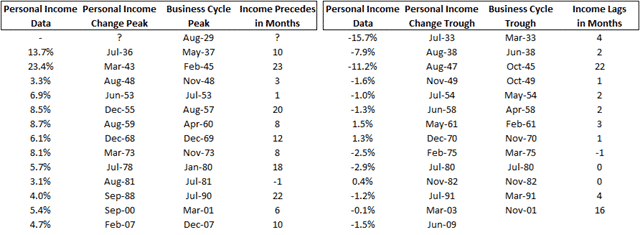Personal income and recessions since 1929
Last year at this time I posted “The Economy’s Four Horsemen,” which described macro cause and effect leading into and out of recessions. When looking at income, spending, output and employment, it is income which is the steer variable going into a downturn. Year-on-year changes in income precede changes in spending, output, employment and recession. So, in order to gauge what is likely to occur in any business cycle downturn and plan your business spending accordingly, you need to know what is happening to personal income.
To get a grip on this, I am going to look back at prior monthly data series on personal income dating to 1929. What I am looking for is to pinpoint when in the economic cycle the change in personal income reverses course and whether this presages recoveries as well as recessions.
Here goes.
(click on image to enlarge)
*Note on data: I am using a six month average of the year-on-year change in inflation-adjusted personal income.
Top in personal income growth precedes recession. What I found is that a downturn in the change in personal income almost always precedes recession – and often by a large margin. This proves that an individual business could look at the data on personal income and get a hint of an impending downturn – and react accordingly.
War used to stoke domestic income growth. There were a few false tops, however. Most of them were war-related. For example, during World War II, there was a false top in 1941. But, by mid-1942, wartime production caused a renewed boom in personal income. the lag between the false top of Sep 1941 and the renewed turn in Jun 1942 was pretty significant. But, this was a clear aberration. As were the false tops in Dec 1950 associated with the Korean War and the ones in Feb 1966 and Nov 1968 associated with the Vietnam War. It seems post-depression, the ginning up of the military industrial complex was a significant factor in preventing economic bust.
Near-recessions in the mid-1970s and 1980s. After the Wars, a mid-1970s and mid-1980s dip were evident as well. However, in neither case did the change in inflation-adjusted personal income go negative. Think of these as almost-recessions. The markets went lower as well. In the mid-1970s, the near-recession personal income trough came in Jul 1977. The Dow peaked in Dec 1976 and kept falling until Feb 1978. In the mid-1980s, the numbers hit a trough of 1.9% in September 1987 when the stock market crashed. There were relapses in 1993 and 1996 as well. But, markets did not fall.
Recovery seems to precede uptick in income growth. While incomes suffer before recession on the way to recession, they lag on the way out, making recessions that much more painful. (See chart above). An increase in the change in personal income does not presage recovery.
Income-less recoveries in 1991, 2001, and 2009. In each of the last three recessions, average year-on-year real income changes were negative. It is still negative now (-2.6% year-on-year, –2.5% average year-on-year, and –1.3% year-on-year adjusted for inflation).
So what does this say about the current cycle?
There are no false bottoms in the real income data. So,the data suggest that we are in recovery (maximum decline in personal income was November 2008), but that we are still in a very weak period in which a double dip is possible (average real personal income change is still –1.3%). Also, average real personal income losses have been less than they were in 1980 when we were in the first dip of the last double dip recession – one benefit of not having high inflation.
As far as I can ascertain, the data don’t really reveal any patterns between the stock market and personal income.

Comments are closed.